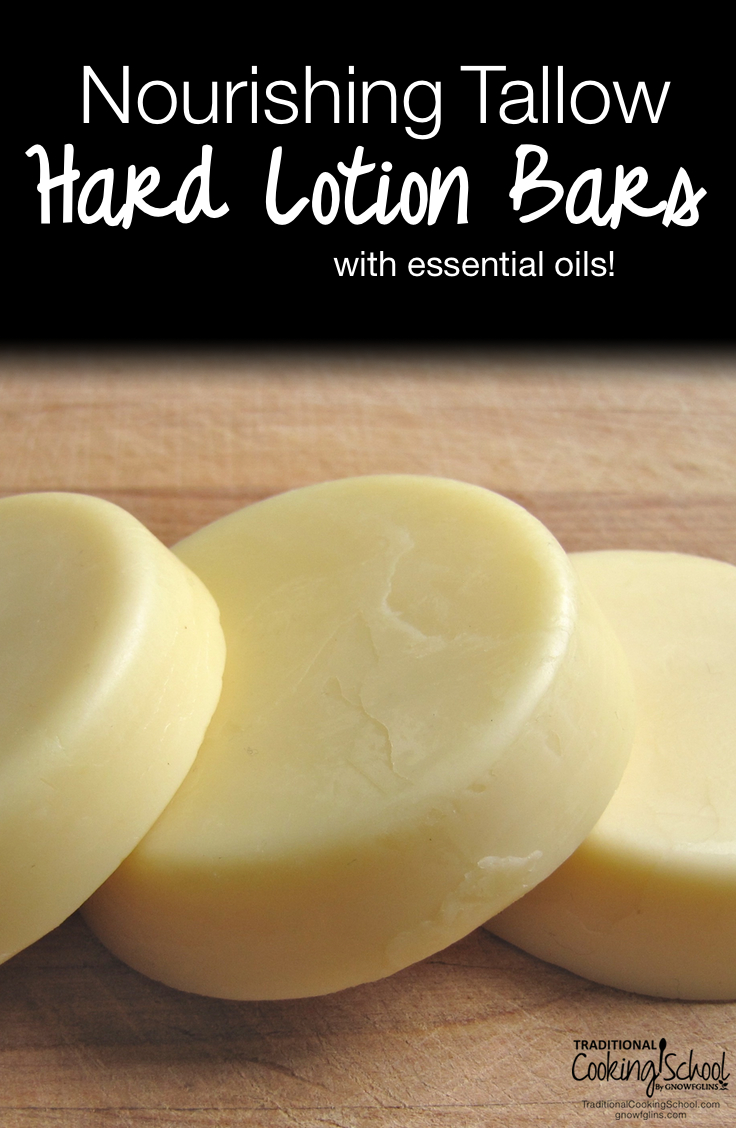
There’s just 1 problem with my homemade tallow balm…
I can’t use it on my hands and still get things done!
Don’t get me wrong — tallow balm isn’t greasy and I still love it. Yet it is soft, thick, and wet. Not so practical for hands that are busy typing, touching, stirring, cooking, tasting, and cleaning.
At least… not practical unless I want to leave a trail of it everywhere I go. 😉 Which I don’t!
A hard lotion bar, on the other hand, can be applied to the hands regularly without gunking-up everything one touches. Why not combine the the best of both into one?
Introducing tallow hard lotion bars! 🙂
My Experience With Tallow Balm
Before I get to the tallow lotion bar adventure, I want to tell you about my recent experience with tallow balm. Just to show you how in love I am with tallow.
I was in Arizona and got quite badly sunburned on my face, arms, and neck. It was painful and I was really red. It hurt physically, but it also hurt my vanity because I was due to attend a small business conference and I didn’t want to arrive looking like a tomato!
So I applied my tallow balm, hard lotion, and aloe vera frequently. Mostly I used tallow balm, liberally applied several times a day. Even to my face. My skin soaked it right up. In addition to being burned, my skin was extremely thirsty because I was in dry Arizona.
What happened? The burn healed miraculously. I felt no pain after the first night. I had no peeling or dryness at any point — and I still don’t even now, 2 weeks later.
And how did I look? Well, still a little rosy for 3 to 4 days! But not as red as a tomato. My skin moved more quickly toward sun-kissed than usual.
I’m totally sold on tallow, so now you know another reason why I’m so eager to get it in a form I can use on my hands regularly, too!
Click here to read why tallow is so awesome for skin care, and to get my tallow balm recipe.
Or if you’d like to buy grassfed tallow balm, I highly recommend Vintage Tradition. Get more info here.
Making Trial Tallow Hard Lotion Bars
When the idea for a tallow hard lotion bar hit me, I emailed Renee at MadeOn Hard Lotion for advice. I knew that her DIY lotion bar kit — containing coconut oil, shea butter, and beeswax — would be the ideal starting place for my tallow hard lotion bar, because… it makes a great hard lotion bar!
Where could I add tallow, though? Tallow is soft like coconut oil and soothing like shea butter. Should I substitute tallow for the coconut oil or for the shea butter? Or, should I keep both coconut oil and shea butter in the original recipe, and add tallow, too? (The beeswax wasn’t going anywhere because that’s what makes the lotion bar firm.)
Renee and I emailed back and forth about possibilities, and I came up with 3 trial recipes. I used her DIY kit for the coconut oil, shea butter, and beeswax. And my own grass-fed tallow.
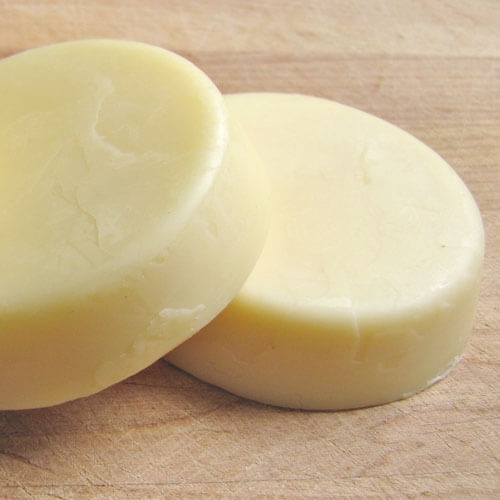
Nourishing Tallow Hard Lotion Bars
Ingredients
- 1 part shea butter
- 1 part grass-fed tallow
- 1 part beeswax pastilles
- essential oil *optional
Instructions
-
Melt all ingredients together, except essential oils, until just barely melted.
-
Add essential oils and stir well.
-
Pour into molds (you can use practically anything).
-
Let cool and harden.
-
Pop out of molds.
-
It's that easy!
Recipe Notes
Variation #1
1 part organic, extra virgin coconut oil
1 part grass-fed tallow
1 part beeswax
essential oil* (optional)
Melt all ingredients together, except essential oils, until just barely melted.
Add essential oils and stir well.
Pour into molds (you can use practically anything).
Let cool and harden.
Pop out of molds.
It's that easy!
Variation #2
1 part organic, extra virgin coconut oil
1 part beeswax
1/2 part shea butter
1/2 part grass-fed tallow
essential oil* (optional)
Melt all ingredients together, except essential oils, until just barely melted.
Add essential oils and stir well.
Pour into molds (you can use practically anything).
Let cool and harden.
Pop out of molds.
It's that easy!
*About essential oils: They are concentrated, so use sparingly. I'd suggest starting at 3 to 6 drops of straight essential oil(s) for a batch this size. Scale up or down as needed. I used my Skin Care blend of oils, already diluted in a cucumber oil base, so I added 1/2 teaspoon.
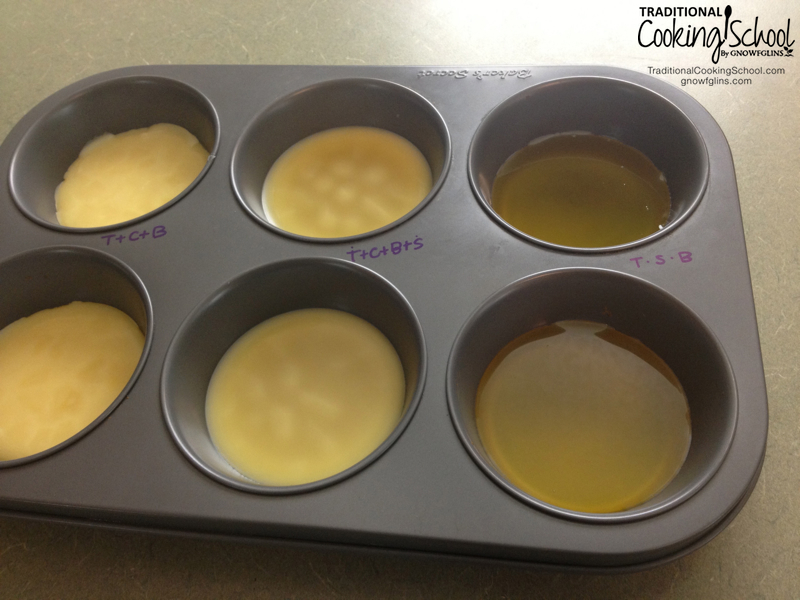
You might need to freeze them to assist the popping out — I didn’t.
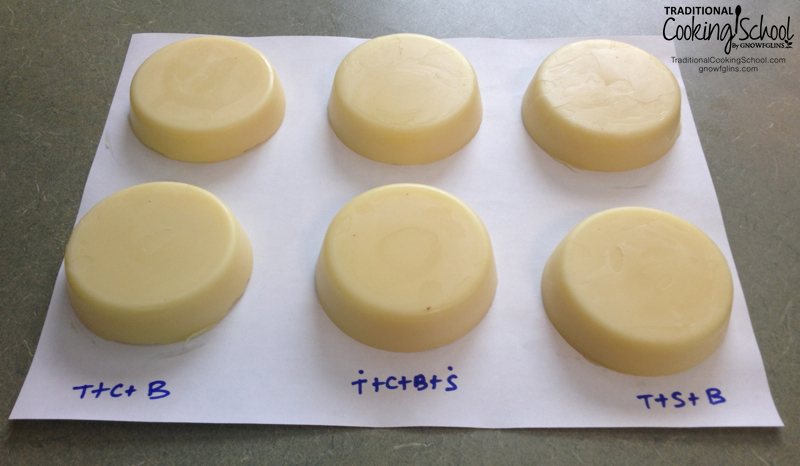
Curious about my markings? 🙂
T = tallow / C = coconut oil / B = beeswax / S = shea butter
dot = half as much quantity as the others
Using Tallow Hard Lotion Bars
Easy! These instructions are straight from the expert, Renee at MadeOn Hard Lotion:
You gently rub it in your hands to apply hard lotion. Your normal body temperature causes the lotion to soften on contact with the skin. The ingredients will start to immediately meld into your skin. It only takes a few seconds to coat the skin and only a small amount of the lotion bar is necessary.
Which Recipe Turned Out The Best?
To be truthful, they’re all very similar and I like them all. It is hard to tell much difference!
They’re all slightly more wet feeling than the original hard lotion bars. This is from the tallow. However, the bars are a huge improvement over the balm when used on hands. Which is, after all, what I wanted to achieve. 🙂
They smell slightly sweet from the beeswax, and not meaty at all. (My tallow is mild.)
Recipe #1 is my least favorite (though I still like it a lot). It is a smidge more “greasy” than the other bars, and I presume that’s because there’s no shea butter (which balances out the oiliness of tallow or coconut oil). However, this bar is easier overall to make because coconut oil and beeswax are more readily available, whereas shea butter is more of a specialty item. Perhaps I’m off base on this, but that’s how I would feel when shopping for ingredients.
Recipe #2 wins in both feel and smell. My tallow is mild but because it is used in the smallest quantity in this bar, the other oils’ sweet smells really shine. Also, this is the least “greasy” bar. Again because tallow is used in the least quantity (1/6).
Recipe #3 is a winner in terms of having the highest concentration of tallow (1/3) while still keeping a great feel and great smell.
My verdict: I’m going for #3 for myself but will be giving #2 for gifts! 🙂
Tallow Balm Or Tallow Hard Lotion Bars?
These tallow bars don’t replace my DIY tallow balm (or buy it right here). No way! I will continue to use tallow balm on large areas of the body that are usually covered (it spreads really well) for both moisturizing and medicinal properties. The tallow bars work well for hands, feet, or parts of the body that touch a lot.
I’ve given both tallow balm and tallow bars as gifts recently. I consider the person who will be using it, the possible uses, and choose according to what I think will be best. Or I give both. 🙂
Want to give this a try?
Depending on which recipe you choose, you’ll need coconut oil, shea butter, and beeswax, and grass-fed tallow.
You can get the first 3 items on your own or via the DIY hard lotion kit from MadeOn Hard Lotion.
I’d suggest checking locally for grass-fed tallow. If you can’t find anything, try US Wellness Meats.
Don’t Have Time For DIY? The Best Place To Buy…
Perhaps you don’t have time to make tallow balm or plain just don’t want to make it yourself… no problem! You’ll be happy to know that Mr. Gardner’s company, Vintage Tradition, offers whole food, grass-fed tallow balm right here!
It’s made from only 3 ingredients: 100% grassfed tallow, extra virgin olive oil, and therapeutic grade essential oils. I really, really love the scent of the Pretty Girl version pictured above… plus it really works on my KP rash!
They also offer tallow-based lip balm and deodorant… which are really great products, too!
I have tried all their products and love the results on kp rash, sunburns, skin irritation, and more! I actually use the tallow balm regularly now (as of 2019) since I don’t always have my own tallow for homemade!
Let me know how it goes — plus, which recipe works best for YOU. 🙂
...without giving up the foods you love or spending all day in the kitchen!
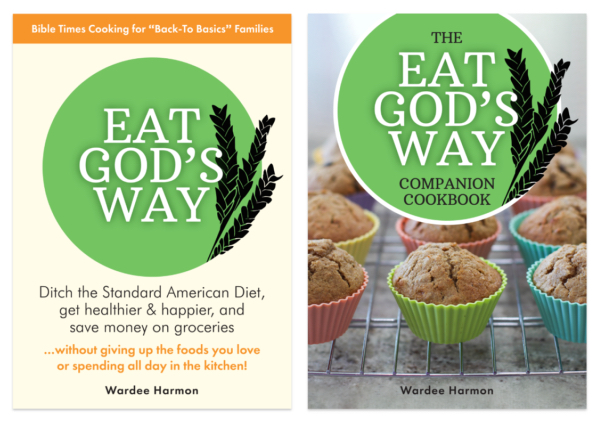
2 free books:
Eat God's Way
Ditch the Standard American Diet, get healthier & happier, and save money on groceries...
We only recommend products and services we wholeheartedly endorse. This post may contain special links through which we earn a small commission if you make a purchase (though your price is the same).

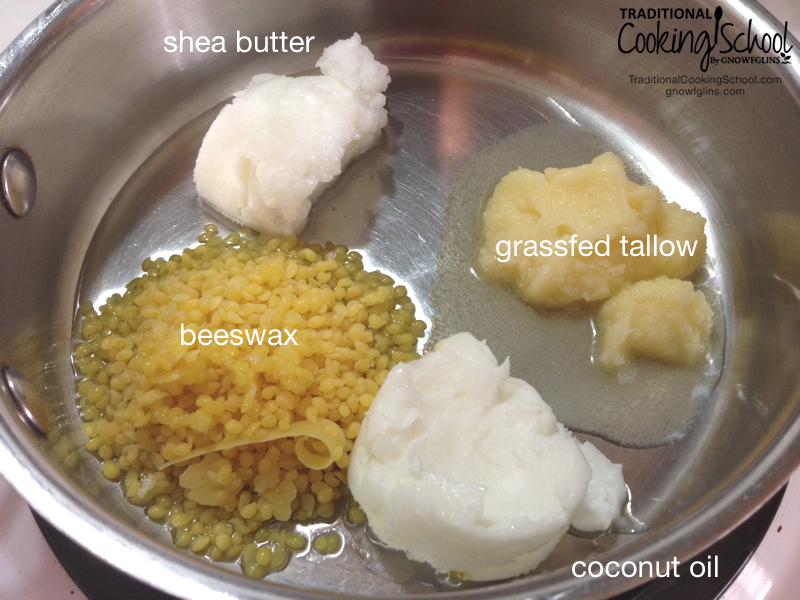
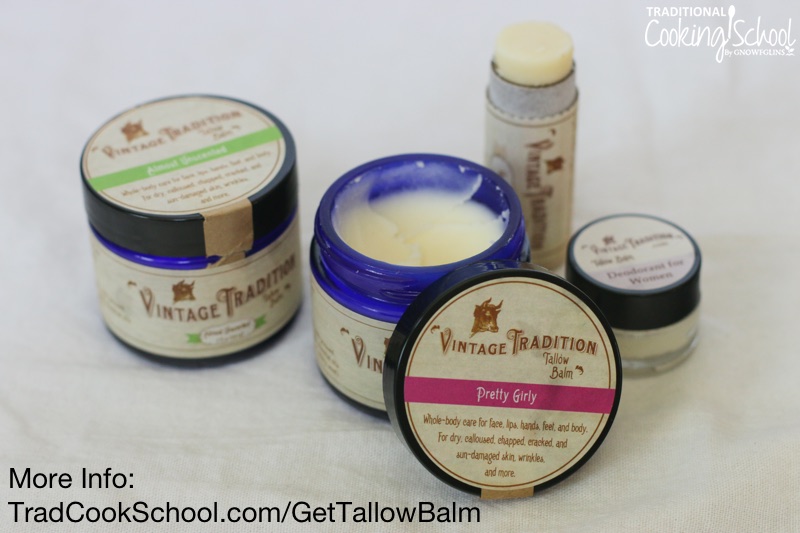

Oh you beat me to it! 🙂 I’ve been making Renee’s hard lotion bars with the DIY kit for over a year now and love it! I had thought about playing around with subbing in some tallow after reading your previous post about the tallow balm. At least now I don’t have to play around with it…I can just use your recipe!
Love them! Thaks for sharing your recipes!
What great timing that this was just posted on FB. I am preparing to use my DIY kit in the next couple days and also just read a post on how great tallow is for the skin. I’m definitely going to try recipe #3. Win-Win. 😀
Thanks for your blog post, I live in Arizona and it’s winter and dry here and I’d love to make myself some lotion bars using tallow! Thanks for blogging about this =)
Can you sub in lard for tallow in these types of recipes?
Mary — I think there’s a comment above where we addressed this.
So can you substitute Lard? I couldn’t find it in the article.
Is your tallow salted? We’re concerned the salt might dry out your skin and are tempted to say ‘no, we don’t recommend it’. But… you could try a small batch and see how it turns out. Let us know if you do and the results.
Millie
GNOWFGLINS Support Team
I just rendered some tallow today and took that opportunity to make these and add some essential oils for treating eczema. So far, we really like them! They smell incredible and soaked right in without feeling greasy. I used recipe #2. If we end up liking these really well, I’ll probably put them in deodorant containers next time! Thanks so much!
Do you think there is a difference if using tallow or lard? Would you happen to know why or why not using pastured lard would be good or not good. I know they use lard for soap.
Great recipes!
Do you know of anyone who sells these? I’m not a DIYer at this stage in my life!
Hi Lydia,
Yes! Try Buffalo Gal Grass-Fed Beauty: http://knowyourfoodpodcast.com/buffalogal
Can you use these bars as a hair conditioner bar?
Hi, Christél,
I am not sure how well this would be as a hair conditioner, I would assume the beeswax would not feel pleasant on the hair and may leave a residue.
~Peggy, TCS Customer Success Team
Thanks for the recipe! I just made these and they are super silky! Do you think they would ship well?
Hi, Nancy.
Properly and securely packed, they should ship well as long as the temperature is not too hot. I would not want them sitting in a hot summer mailbox. 🙂
~Danielle, TCS Customer Success Team
I didn’t see recipe #3. Did I miss it?
Hi, Cindy,
It’s the winner recipe that she has listed first.
1 part shea butter
1 part grass-fed tallow
1 part beeswax pastilles
~Peggy, TCS Customer Success Team
So, when you are presenting the results under “Which turned out the Best,” you are referring to the examples in the photo with you notations. And the recipe you list as #3 is actually the first recipe you presented under the section “Nourishing Tallow Lotion Bars”, and the first and second results in the photo and under “Which turned out the Best” are actually recipe variations 1 and 2 respectively, correct?
It refers to Varations #1, 2, and 3 listed with the recipe instructions.
~Danielle, TCS Customer Success Team
Does it need to be stored in a refrigerator?
Thanks in advance.
If you aren’t going to be used with a month or so, then yes. Or if temperatures are hot, because fat spoils.
–
Makenzie, Customer Success Team
Where is the third recipe that you liked best and can you use arrow root powder to help with the greasy filling
Hi, Colette,
The 3rd recipe is the main recipe she has listed the other two are the variations of the main one. I don’t think arrowroot powder will help.
~Peggy, TCS Customer Success Team